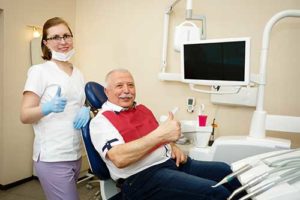 Ridge augmentation is a dental procedure done by a periodontist. Periodontics is the area of dentistry that pertains to the gums and the structures that support the teeth. Periodontal diseases are caused by inflammatory diseases, bacterial infections, gingivitis, dentures, injuries to the mouth, congenital disabilities and developmental defects, and periodontitis. All of which cause bone loss and the gums to pull away from the teeth.
Ridge augmentation is a dental procedure done by a periodontist. Periodontics is the area of dentistry that pertains to the gums and the structures that support the teeth. Periodontal diseases are caused by inflammatory diseases, bacterial infections, gingivitis, dentures, injuries to the mouth, congenital disabilities and developmental defects, and periodontitis. All of which cause bone loss and the gums to pull away from the teeth.
How Common is Ridge Augmentation
According to the Centers for Disease Control and Prevention (CDC), 47.2 percent of adults over the age of 30 and 70.1 percent of adults over the age of 65 have some periodontal disease. As you can see, periodontal diseases are a common problem for a lot of people. People of all ages can have a problem with this area of the mouth due to trauma, and the procedure is also done in preparation for dental implants if necessary.
The jawbone has two ridges of the alveolar ridges made of narrow tissue located below the gum line and provides support for the teeth. Over time the bones start to diminish, especially if you have had many dental extractions or tooth loss. The periodontist will suggest you have a ridge augmentation procedure, like having a bone graft done on your jaw.
Are You a Good Candidate for Ridge Augmentation?
If you have not had any or very little tooth loss in a long time or an extensive amount of dental work done, then you are a good candidate for the procedure. Even if you wear dentures, you can still be a good candidate if the removal of all the teeth was at least five years ago and the gums and jaw have completely healed and settled in place. It is okay if your jaw has been worn down. The purpose is to build it back up. Most people have the ridge augmentation surgical procedure done to repair the jawbone and gums to wear dental implants.
This procedure is a surgical procedure, so your overall health does play a role in the final decision. You may need to have blood work drawn and EKG (electrocardiogram) to check your heart done just as you would if you had any surgical procedure.
Certain diseases and conditions could prevent you from having the procedure, such as the following:
- Uncontrolled diabetes (Insulin-dependent)
- Certain autoimmune diseases
- Some heart conditions
- Certain cancers
The Ridge Augmentation Surgical Procedure
The surgical procedure is done using local sedation. However, you may ask for deeper sedation. Oral conscious sedation, nitrous oxide, and intravenous (IV) medications are all excellent options.
During the surgery, your dentist will clean the tooth sockets and attach the grafting material. Using small screws to anchor the new tissue in place. The anchor stabilizes the graft until it fuses with your alveolar ridge. The dentist will then close the incision with sutures.
Everyone heals at a different pace. It is essential to get plenty of rest and do not perform any strenuous activities. You have mild to moderate pain for the first few weeks. It will get better as time goes on. You will also likely experience swelling and bruising. During this time, your bone tissue will merge with your alveolar ridge. Your recovery time should be six to nine months, but that does not mean you cannot do anything during that timeframe. Your dentist will provide you with more detailed instructions about your recovery, follow-up visit, and your activity level.
If you are looking for a periodontist for ridge augmentation services, call Lovett Dental Pasadena at 281-998-8800 or stop by and visit our website. We follow all Covid-19 rules and regulations for your safety and ours.
